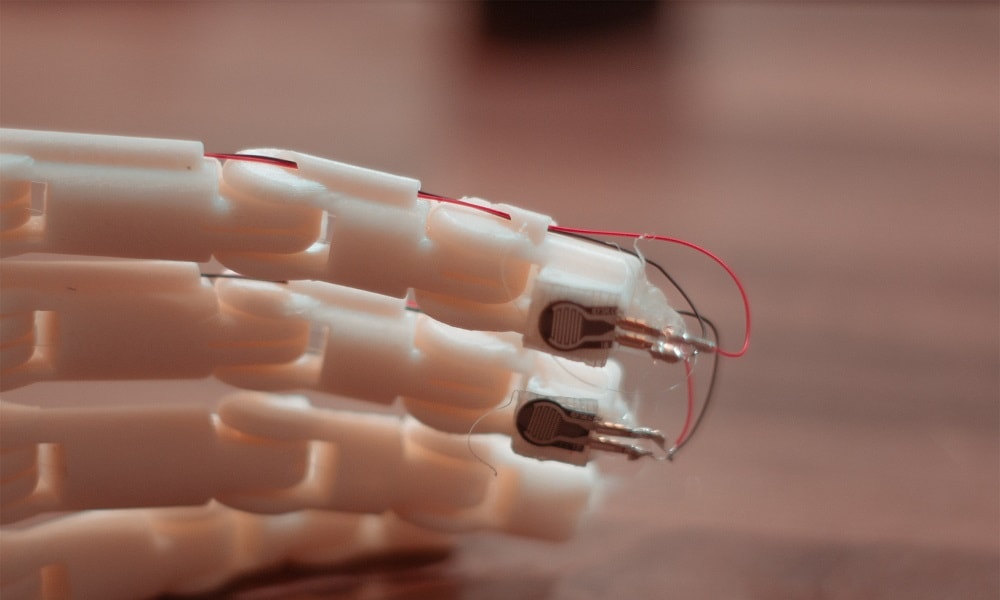3D printed prosthetic arm providing feedbacks
Posted By Lucie Gaget on Mar 25, 2020 | 0 comments
Medical 3D printing is becoming one of the biggest applications of additive manufacturing. In this sector, 3D printing is used for many different kinds of projects, and 3D printing prosthetics is one of them. We’ve already told you about some great projects, but once again additive manufacturing is showing that this technology allows for creating new innovative devices all the time.
A student 3D printed a prosthetic arm, a low-cost device providing feedback. How does it work, and how did this student actually 3D print this? Follow this guide to find out more.
An innovative 3D printed prosthetic arm
This amazing project has been initiated by Lorenzo Spreafico, a student at the University of Leeds. His creation could be a real revolution for all amputees: he created a prosthetic arm with vibrotactile feedback, meaning the amputee could feel when he or she is touching something. This prosthetic arm is his final year project in the Product Design bachelors at the University of Leeds in the UK. And we can say it, this project is really promising.
https://www.3dnatives.com/en/low-cost-3d-printed-prosthetic-arm-090320204/?utm_source=rss&utm_medium=rss&utm_campaign=low-cost-3d-printed-prosthetic-arm-090320204
Prosthetics, even if they are necessary, are already expensive. But prosthetics including advanced technology can be even more expensive, depriving some people of a normal life. Thankfully, Lorenzo Spreafic had the idea to use additive manufacturing to lower the price of this device! The first prototype, called T1 is under €3,500. Indeed, like a lot of objects, prostheses are made of plastic, and totally be made using 3D printing.
Using 3D printing offers the opportunity to create affordable and adapted prosthetics for anyone! This first prototype has been made using Fused Deposition Molding (FDM) technology.
The student explains: “There is a huge gap in the development of prostheses: although we are developing extremely advanced technology to simulate human movement and dexterity, there is much less work done when it comes to simulating human touch“. Indeed, all the touch-based technologies that he knew were not good enough for commercial use or were just prohibitively expensive.
Lorenzo Spreafic chose this angle to create an advanced project. The prosthesis is printed in plastic and implement vibrotactile feedback, meaning that is relays the information about how the person is touching or grabbing an object via vibrations to their skin.
https://www.3dnatives.com/en/low-cost-3d-printed-prosthetic-arm-090320204/
The goal of this feature is to avoid the risks of rejection by using a more realistic proprioception effect (sense of self-movement and body position). How is this feedback process working? The student implemented pressure sensors at the tip of each finger of the prosthesis. They are all connected to vibrating motors at the stump, expressing to the wearer of the device the force they are applying.
The process used here is making this device way cheaper than other myoelectric prosthetic devices on the market. Moreover, it is possible to personalize it, the wearer can adjust the vibration, or remove them completely.
Medical 3D printing: How 3D printed prosthetics are improving patient’s lives
The advantages of additive manufacturing for the creation of prosthetics are quite revolutionary. First, as we just saw, it is a solution to create affordable devices with the same quality as other traditional products. This technology is also the perfect technique for mass-customization, meaning that it is possible to create products perfectly adapted to each patient! Say goodbye to the standard prostheses and hello to new innovative prostheses.
A 3D printed prosthesis has a lower cost and can be fully adapted to the morphology of the patients, it can be adapted to their habits, and their disability thanks to 3D scanning and 3D modeling. Moreover, by adding more advanced technology to additive manufacturing projects, we can now see impressive projects such as this prosthetic arm.
Do you have a medical project in mind? Don’t hesitate to contact our team. If you already have your 3D files, feel free to upload them to our online 3D printing service! You will receive your part in a few days.


 Connect with Google
Connect with Google Connect with Facebook
Connect with Facebook

